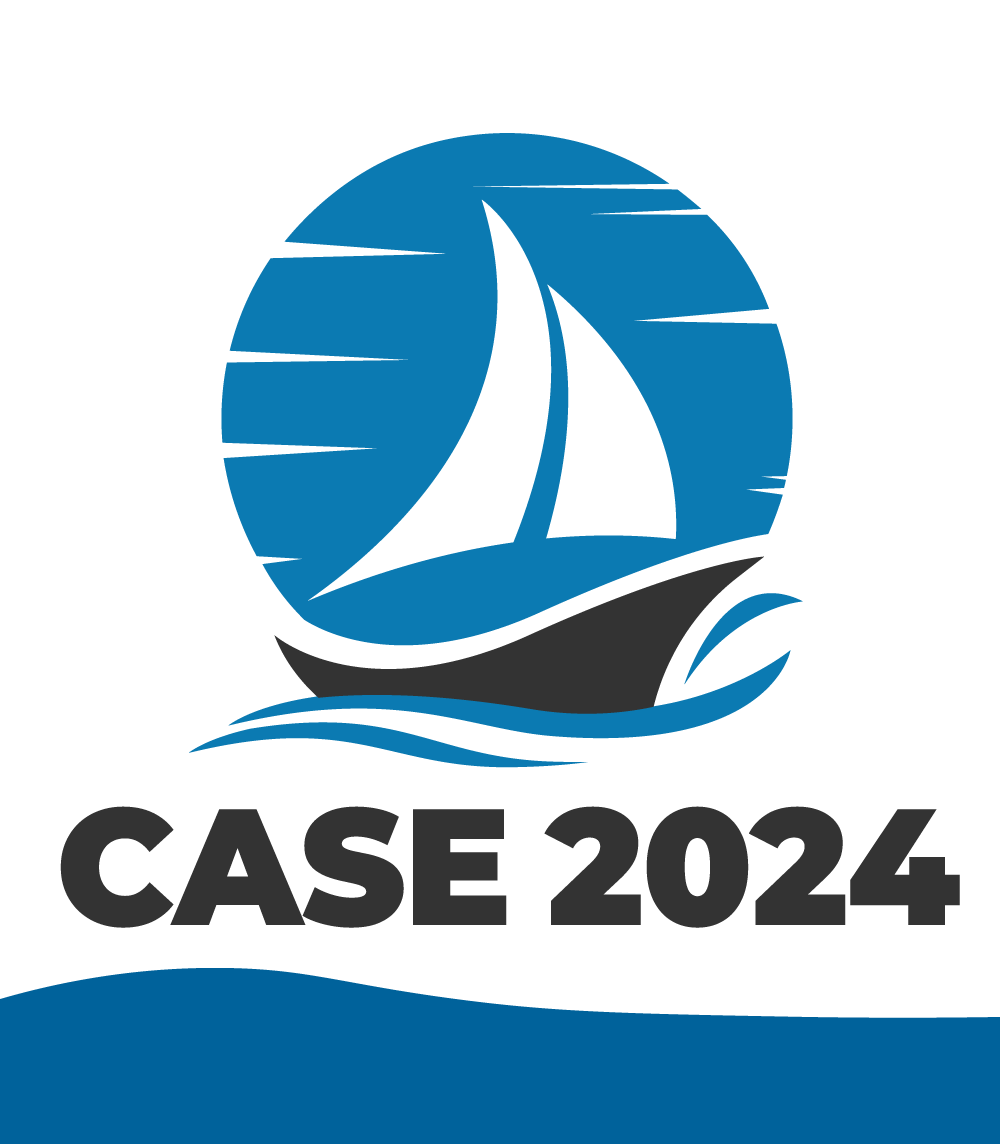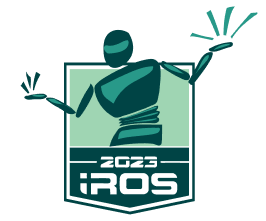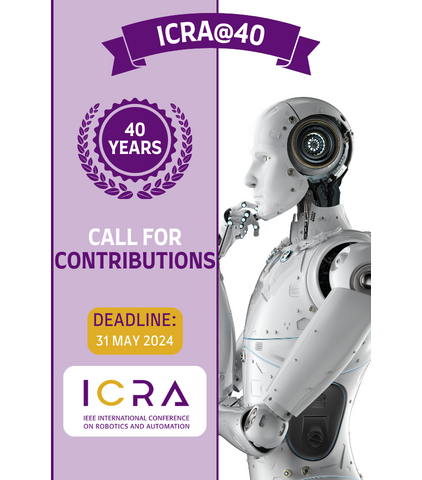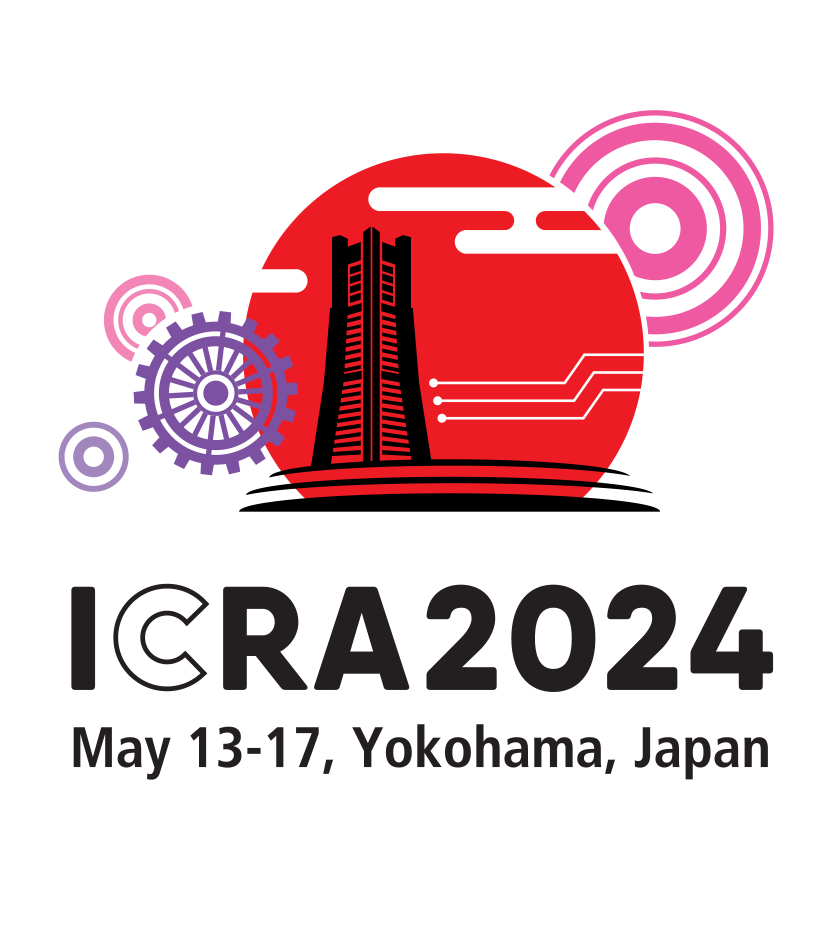Latest News
IEEE Fellow is a distinction reserved for select IEEE members. The honor is conferred by the Board of Directors upon a person with an extraordinary record of accomplishments in any of the IEEE fields of interest.
If you know of an IEEE colleague who is a Senior Member or Life Senior Member in good standing, has completed five years of service in any grade of IEEE Membership and who has made an outstanding contribution to the electronic or electrical engineering profession, you can nominate this person in one of four categories: Application Engineer/Practitioner, Educator, Research Engineer/Scientist or Technical Leader.
Nominations for the Fellow Class of 2015 are now being accepted. To learn more about the Fellow program and the application process, visit the About the IEEE Fellow Program page. The deadline is 1 March 2014.
posted 30 January 2014
The IEEE Robotics & Automation Magazine will feature a special issue on Wearable Robotics in December for 2014 and the deadline for submissions is 1 March.
A Wearable Robot (WR) is an artificial apparatus that is placed in a close fit to the human’s body, thereby moving and working in synchrony with its limbs. Examples of WRs include active exoskeletons, which are worn in parallel to the user’s body so as to augment its performance, and active limb-prostheses, which are worn in series to the user’s body so as to replace some missing extremity. WRs make it possible to realize a human-robot symbiotic system with enhanced/restored strength, speed, endurance and energetic autonomy. Practical applications of WRs range from physical assistance of the elderly, disabled people and heavy duty workers to the functional rehabilitation and restoration of lost functions.
Since the last decade, significant advances have occurred in Wearable Robotics, which is now attracting the interest from the industry and the media. However, the development of a complete and functional WR is still a very challenging task, which deserves innovations under several regards, including ergonomics, kinematics, dynamics, actuation, interaction control and energetics. In this context, this special issue focuses on complete and working Wearable Robots, and specifically targets at presenting new scientific results and methodologies that can assist the practicing engineer in the design, development, control and validation of novel WR systems.
Scope, Description and information
Researchers working in Industry and Academia are invited to submit their original and unpublished research results on technological and experimental aspects associated with the design, development, control and validation of complete and working Wearable Robotic systems.
Topics of interest include:
• Power extenders for material handling;
• Robotic orthoses for physical assistance and rehabilitation;
• Active limb-prostheses;
• Wearable haptic exoskeletons;
• Novel design and validation methodologies for wearable robots.
Guest Editors
• Rocco Vertechy, PERCRO Lab, Scuola Superiore Sant’Anna, Pisa (Italy)
• Dino Accoto, Biomedical Robotics and Biomicrosystems Lab, University Campus Bio-Medico di Roma, Rome (Italy)
• Hugh Herr, MIT Media Lab, Massachusetts Institute of Technology, Cambridge (MA, USA)
Deadline for Paper Submission: 1 March 2014
First Review: 31 May 2014
Final Review: 1 September 2014
Publication Schedule: December 2014
The IEEE Robotics & Automation Society recognizes the following individuals for their outstanding accomplishments and service to RAS and the robotics and automation community. They will be honored during an award luncheon to be held at ICRA 2014, on 4 June in Hong Kong. Please join us in congratulating these outstanding recipients!
RAS George Saridis Leadership Award in Robotics and Automation
Paolo Dario - The BioRobotics Institute, Italy
"For pioneering and consolidating robotics as pervasive technology, with interdisciplinary and visionary ideas, extending RAS leadership through inclusiveness towards other communities"
Oussama Khatib - Stanford University, CA United States
"In recognition of his vision and leadership in introducing and nurturing important innovations in conferences in robotics and automation"
IEEE RAS Distinguished Service Award
Anthony A. (Tony) Maciejewski - Colorado State University, CO United States
"For contributions to RAS technical activities and continuing service as Vice President for Financial Activities"
Rosalyn Graham Snyder - Raleigh, NC United States
"For her never ending commitment in the support of all RAS activities in 25 years of service from the start of the society to the fastest growing society of IEEE"
RAS Early Career Award (Academic)
Kyu Jin Cho - Seoul National University, Seoul, Korea
"Fundamental contributions to soft robotics and biologically inspired robot design"
Davide Scaramuzza - University of Zurich, Switzerland
"For his major contributions to robot vision and visually-guided micro aerial vehicles"
RAS Early Career Award (Industry/Government)
Torsten Kroeger - Stanford University, United States and Reflexxes GmbH, Germany
"For his scientific contributions to online trajectory generation and sensor-based motion control of robot systems widely used in industry and academia"
IEEE Inaba Technical Award for Innovation Leading to Production
Roland Siegwart - Eth Zurich, Switzerland
"For outstanding contributions in fostering innovation and entrepreneurship, for the development of novel robotic technologies and the transition of this technology to industry"
IEEE Robotics and Automation Award for Product Innovation
DAIMLER AG, Mercedes-Benz Cars
"In recognition of "Robot Farming" Based on Soft Robotics Technologies - A Milestone towards Highly Flexible Robot Manufacturing"
RAS Chapter of the Year Award
Peru Section Chapter
Chair: Antonio Moran
posted 16 January 2014
Nominations are due 31 January 2014 for the 2015 IEEE Technical Field Award in Robotics and Automation. This is the most prestigious award presented by the IEEE in the field of robotics and automation and includes a medal and a $US 10,000 honorarium. IEEE TFAs are awarded for contributions or leadership in a specific field of interest of the IEEE and are among the highest awards presented on behalf of the IEEE Board of Directors.
Visit ieee-ras.org/awards-recognition/ieee-awards a for a description of the award criteria and instructions on submitting a nomination.
The 2014 IEEE Technical Field Award in Robotics and Automation will be presented to Shigeo Hirose of HiBot Corporation, Tokyo, Japan for "contributions to the design and construction of multiple conconventional robotic systems such as snakelike, quadruped walking, wall climbing, and swarm robots." The presentation will take place at the Award Ceremony during ICRA 2014 in Hong Kong.
posted 3 January 2014
Congratulation to the six RAS members elected by the membership to serve a three-year term beginning 1 January 2014. We wish the newly elected members of the Administrative Committee success and thank all candidates afor their willingness to serve and for permitting their names to be included on the ballot.
AdCom Members Elected at Large:

Toshio Fukuda

Hong Zhang
AdCom Member from RAS Geographic Area 1 (the Americas):

Seth Hutchinson
AdCom Member from RAS Geographical Area 2 (Europe, Africa, Middle East--IEEE Region 8):

Bradley Nelson
AdCom Members from RAS Geogrpahical Area 3 (Asia, Australia, Pacific Rim):

Dong-Soo Kwon

Hong Qiao
posted 26 December 2013
Congratulations to Robert Ladig of Noji, Japan, as the winner of this year's contest!!
Robert provided the following description of this image:
"Once invented to stop an ink pot from leaking, now used in aerial robotics: The gimbal (The GimBall, an insect-like, crash-happy flying robot. Developed by Adrien Briod et al. and presented at IROS2013)"
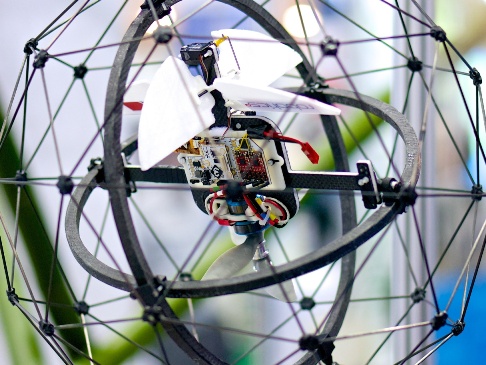
Thank you to Everyone that participated!
posted 10 December 2013
Congratulations to the following RAS Members - elevated to Fellow grade, effective 1 January 2014!
2014 RAS Fellows evaluated by the IEEE Robotics & Automation Society:
Martin Buss
Technische Universitaet Muenchen, Germany
"for contributions to haptic telepresence systems and autonomous robots"
James Colgate
Northwestern University, USA
"for contributions to the field of haptics"
Liyi Dai
US Army Research Office, USA
"for leadership and contributions to discrete event systems and singular systems"
Daniel Lee
University of Pennsylvania, USA
"for contributions to machine learning algorithms for perception and motor control"
John Leonard
Massachusetts Institute of Technology, USA
"for contributions to navigation and mapping for mobile robots and autonomous underwater vehicles"
Stefan Schaal
University of Southern California, USA
"for contributions to robot learning and modular motion planning"
Metin Sitti
Carnegie Mellon University, USA
"for contributions to micro and nano-scale robotic systems"
Hong Zhang
University of Alberta, Canada
"for contributions to collective robotics and intelligent sensing in oil sand mining"
2014 RAS Fellows evaluated by other IEEE Societies:
Evaluated by the IEEE Computer Society:
Rene Vidal
Johns Hopkins University, USA
"for contributions to subspace clustering and motion segmentation in computer vision"
Evaluated by the IEEE Computational Intelligence Society:
Robert Kozma
University of Memphis, USA
"for contributions to pattern-based computation based on large-scale networks and random graphs"
Evaluated by the IEEE Computational Intelligence Society:
Kazuo Tanaka
University of Electro-Communications, Japan
"for contributions to fuzzy control system design and analysis"
Evaluated by the IEEE Control Systems Society:
Ali Jadbabaie
University of Pennsylvania, USA
"for contributions to the theory of multi-agent coordination and control"
Evaluated by the IEEE Engineering in Medicine and Biology Society:
Hermano Krebs
Massachusetts Institute of Technology, USA
"for contributions to rehabilitation robotics and the understanding of neuro-rehabilitation"
posted 3 December 2013
The IEEE/RSJ International Conference on Intelligent Robots and Systems (IROS2013) was held on
3-8 November 2013, at Tokyo Big Sight, Japan. Congratulations to the following winners - announced on 6 November.
IROS Harashima Award for Innovative Technologies
To honor Professor Fumio Harashima, the Honorary Founding Chair of IROS conferences, by recognizing outstanding contributions of an individual of the IROS community, who has pioneered activities in robotics and intelligent systems
Kazuhiro Kosuge, Tohoku University
"For his contributions on Human-Robot Interaction and Mechatronic Systems and for his leadership in the community"
IROS 2013 Best Paper Award - two winners this year
To recognize the most outstanding paper presented at the conference, based on quality of contribution, of a written paper, and of the oral presentation. Sponsored by RSJ and SICE
Maxime Meilland and Andrew I. Comport
"On Unifying Key-Frame and Voxel-Based Dense Visual SLAM at Large Scales"
Peter Corke, Rohan Paul, Winston Churchill and Paul Newman
"Dealing with Shadows: Capturing Intrinsic Scene Appearance for Image-Based Outdoor Localization"
IROS 2013 Best Student Paper Award
To recognize the most outstanding paper authored primarily and presented by a student at the conference, based on the quality of the contribution, of the written paper and of the oral presentation. Sponsored by IROS 2013 Conference
Yaxiaer Yalikun
"Multiple Microfluidic Stream Based Manipulation for Single Cell Handling"
IROS 2013 Best Video Award
A dedicated Award will be assigned to recognize the most outstanding IROS 2013 Video, based on technical merit, evidence of impact on the field of the reported achievements, practical significance of the applications, quality and clarity of the video and of the narration and quality of the presentation at the IROS 2013 conference. Sponsored by IROS 2013 Conference
Ji-suk Kim, Gwang-pil Jung, Je-sung Koh and Kyu-jin Cho
"Meso-scale robot assembly using shape memory polymer rivet fastener"
Best ICROS Application Paper Award
Sponsored by the Institute of Control, Robotics, and Systems (ICROS)
Besir Celebi, Mustafa Yalcin and Volkan Patoglu
"AssitOn-Knee: A Self-Aligning Knee Exoskeleton"
NTF Award for Entertainment Robots and Systems
Started in 2007, this award is to encourage research and development of "entertainment robots and systems," and new technologies for future entertainment. Sponsored by the New Technology Foundation
Michael Lichtenstern, Michael Angermann, Martin Frassl, Gunther Berthold, Brian J. Julian and Daniela Rus
"Pose and Paste - An Intuitive Interface for Remote Navigation of a Multi-Robot System"
JTCF Novel Technology Paper Award for Amusement Culture
This award recognizes practical technology contributing to toys, toy models, and amusement culture. Sponsored by the Japan Toy Culture Foundation
Valiallah Monajjemi, Jens Wawerla, Richard Vaughan and Greg Mori
"HRI in the Sky: Creating and Commanding Teams of UAVs with a Vision-Mediated Gestural Interface"
RoboCup Best Paper Award - two winners this year
Sponsored by the RoboCup Federation
Korbinian Schmid, Teodor Tomi?, Felix Ruess, Heiko Hirschmüller and Michael Suppa
"Stereo Vision Based Indoor/Outdoor Navigation for Flying Robots"
Francis Colas, Srivatsa Mehesh, François Pomerleau, Ming Liu and Roland Siegwart
"3D Path Planning and Execution for Search and Rescue Ground Robots"
IROS CoTeSys Cognitive Robotics Best Paper Award
Started in 2010, this award is to produce interdisciplinary research on cognition for technical systems (CoTeSys) and advancements of cognitive robotics in industry, home applications, and daily life. Sponsored by the German Cluster of Excellence, CoTeSys
Juan Fasola and Maja J. Matari
"Using Semantic Fields to Model Dynamic Spatial Relations in a Robot Architecture for Natural Language Instruction of Service Robots"
posted 28 November 2013
Don't forget to vote! This Election closes 22 November!!
RAS members are voting to elect six new members of the RAS Administrative Committee to serve 3-year terms beginning in January 2014. All RAS members (Graduate Student Members and above) have received voting instructions, the biographies, and statements of the candidates by email. RAS membership must be active as of 10 September 2013 to be eligible to vote. Members who do not have valid emails registered with the IEEE or have opted not to receive e-mail from IEEE, have received their election materials by post.
Click here to review the candidates' bios and position statements.
posted 15 November 2013
It's not too late!! Submit your entries today!

Do you enjoy photography, have an artistic eye and are up for a challenge? If you attended IROS 2013 in Tokyo, Japan, RAS invites you to participate in a photography contest. Photos should capture the essence of IROS, and exhibit creativity and technical skill. You are invited to submit up to three original photos taken during the event from 3-8 November 2013. The winner will receive an iPad mini.
All photos submitted to this contest may be used by RAS in future promotions, the RAS Facebook page, the RAS website or other opportunities.
Deadline for Submission of Photos: 15 November 2013
Judging: Photos will be placed in an album on the RAS Facebook Page. The photo with the most "likes" by 30 November will be the winner. RAS members and the public will be encouraged to vote for their favorite photo.
Please use the following form to submit your entry:
adobeformscentral.com/IROS2013
For questions, or to submit your entry via email: RAS@ieee.org
posted 14 November 2013
The ninth annual IEEE International Conference on Automation Science and Engineering (CASE 2013) was held on 17-21 August 2013, in Madison, Wisconsin, USA. IEEE CASE represents the flagship automation conference of the IEEE Robotics and Automation Society. The conference aims to bring together researchers in automation from both industry and academia, together with industrial practitioners, to present and discuss the latest advances and developments in automation science and engineering.
Congratulations to the following winners of IEEE RAS and CASE Awards:
IEEE Transactions on Automation Science and Engineering
Best Paper Award
Authors: Jason B. Forsyth, Thomas L. Martin, Deborah Young-Corbett, and Ed Dorsa
for the paper "Feasibility of Intelligent Monitoring of Construction Workers for Carbon Monoxide Poisoning"
Best Conference Paper Award
Authors: Lili Chen, Xi Zhang and Changyue Song
for the paper "A Severity Measurement System for Obstructive Sleep Apnea Discrimination Using a Single ECG Signal"
Best Application Paper Award
Authors: Kevin Weekly, Donghyun Rim, Alexandre Bayen, Lin Zhang, William W Nazaroff and Costas Spanos
for the paper "Low-Cost Coarse Airborne Particulate Matter Sensing for Indoor Occupancy Detection"
Best Student Paper Award
Authors: Wim Devesse, Marcus Ramteen, Lei Feng and Jan Wikander
for the paper "A Real-Time Optimal Control Method for Swing-Free Tower Crane Motions"
RAS members will vote to elect six new members of the RAS Administrative Committee to serve 3-year terms beginning in January 2014.

All RAS members (Graduate Student Members and above) will receive their voting instructions, the biographies, and statements of the candidates by email. RAS membership must be active as of 10 September 2013 to be eligible to vote. Members who do not have valid emails registered with the IEEE or have opted not to receive mailings from the IEEE, will receive their election materials by post. They will have the option of returning a paper ballot or voting on-line. The election will close November 22.
The list of Candidates and bios are available here. Please use your IEEE username and password to access the page.
Do you enjoy photography, have an artistic eye and are up for a challenge? If you are attending IROS 2013 in Tokyo, Japan, RAS invites you to participate in a photography contest. Photos should capture the essence of IROS, and exhibit creativity and technical skill. You are invited to submit up to three original photos taken during the event from 3-8 November 2013. The winner will receive an iPad mini.
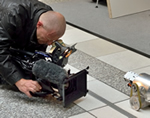
All photos submitted to this contest may be used by RAS in future promotions, the RAS Facebook page, the RAS website or other opportunities.
Deadline for Submission of Photos: 15 November 2013
Judging: Photos will be placed in an album on the RAS Facebook Page. The photo with the most "likes" by 30 November will be the winner. RAS members and the public will be encouraged to vote for their favorite photo.
Please use the following form to submit your entry:
adobeformscentral.com/IROS2013
For questions, or to submit your entry via email: RAS@ieee.org
posted 23 October 2013
IEEE Robotics & Automation Special Interest Group on Humanitarian Technology (RAS SIGHT) Chair, Raj Madhavan is a featured speaker at the upcoming IEEE Global Humanitarian Technology Conference being held 20-23 October in Silicon Valley, CA USA. Madhavan will present Robotics and Automation Technologies for Improving the Quality of Life for Humanity.
Shigeo Hirose, IEEE Fellow, has been named the recipient of the 2014 IEEE ROBOTICS AND AUTOMATION AWARD for "contributions to the design and construction of multiple nonconventional robotic systems such as snakelike, quadruped walking, wall climbing, and swarm robots."

Dr. Shigeo Hirose succeeded in demonstrating a smooth undulating motion of a 2m long snake-like robot ACM-III in 1972 for the first time in the world. He received the Ph.D. degree with the biomechanical study of real snake and snake-like robots in 1976. At the Tokyo Institute of Technology he had the following academic positions: assistant professor from 1976 to 1979, associate professor from 1979 to 1992, professor from 1992 to 2011, and distinguished professor from 2011 to 2013.
Dr. Hirose published a book with the title "Biologically Inspired Robots" (Oxford University Press) in 1993. In that publication he coined the unique research field of biologically inspired robotics.
Dr. Hirose has always been interested in creative design of robotic mechanisms and in their control system. He developed more than 150 robots including snake-like mobile robots, articulated robot-arms, quadruped walking robots, and wheeled & crawler mobile robots. Main objectives in his works were to realize robots for search and rescue operation, humanitarian demining, medical & welfare and rovers for planetary exploration.
Dr. Hirose was awarded with more than 50 academic awards, including the Joseph Engelberger Robotics Award from Robotic Industries Association (2009), Medal with Purple Ribbon from Japanese government (2006), Award of Merits from IFToMM (2004), the first Pioneer in Robotics & Automation Award (1999) from IEEE Robotics & Automation Society.
Dr. Hirose is an IEEE Fellow and he is currently holding the CTO position at HiBot Corporation (founded by his former students at the Hirose Robotic Laboratory) a position as Professor Emeritus of Tokyo Institute of Technology, and Visiting Professor at Ritsumeikan University.
Dr. Hirose will receive this most prestigious IEEE-level award in a formal presentation at a 2014 IEEE venue to be determined. If you think you know someone in the IEEE Robotics & Automation Society who may be eligible for an IEEE Technical Field Award, please visit www.ieee.org/awards for more information on eligibility and general award criteria.
The nomination deadline for the 2015 IEEE Technical Field Awards is 31 January 2014.
Voting starts 11 October 2013
RAS members will vote to elect six new members of the RAS Administrative Committee to serve 3-year terms beginning in January 2014. All RAS members (Graduate Student Members and above) will receive their voting instructions, the biographies, and statements of the candidates by email. RAS membership must be active as of 10 September 2013 to be eligible to vote. Members who do not have valid emails registered with the IEEE or have opted not to receive mailings from the IEEE, will receive their election materials by post. They will have the option of returning a paper ballot or voting on-line. The election will close November 22.
RAS Geographical Area 1:
IEEE Regions 1, 2, 3, 4, 5, 6, 7, 9 (Americas)
RAS Geographical Area 2:
IEEE Region 8 (Europe, Middle East & Africa)
RAS Geographical Area 3:
IEEE Region 10 (Asia & Pacific)
Candidate Biographies
- François Chaumette, GEO Area 2
- Nak Young Chong, GEO Area 3
- Gregory Dudek, GEO Area 1
- Toshio Fukuda, GEO Area 3
- Eugenio Guglielmelli, GEO Area 2
- Tamas Haidegger, GEO Area 2
- Seth Hutchinson, GEO Area 1
- Dong-Soo Kwon, GEO Area 3
- Peter B. Luh, GEO Area 1
- Bradley J. Nelson, GEO Area 2
- Hong Qiao, GEO Area 3
- Michael Yu Wang, GEO Area 3
- Hong Zhang, GEO Area 1
RAS Vice President of Conference Activities, Nikos Papanikolopoulos and the RAS Conference Activities Board are seeking proposals to host ICRA 2018 to be held in Oceania (IEEE Region 10).
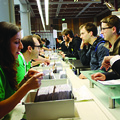 Minimum proposal information required includes the following: Location and plan, venue description, accessibility; Proposed organizers provide information about their backgrounds and interactions with the RAS; Technical program discussion, in particular new events or changes in organization of technical program; Budget plan; Milestones to be met; Statement of willingness to sign a contract with responsibilities of organizers.
Minimum proposal information required includes the following: Location and plan, venue description, accessibility; Proposed organizers provide information about their backgrounds and interactions with the RAS; Technical program discussion, in particular new events or changes in organization of technical program; Budget plan; Milestones to be met; Statement of willingness to sign a contract with responsibilities of organizers.
The IEEE provides many resources for conference organizers. Before submitting their proposals, candidates are encouraged to visit the following site and review the information: www.ieee.org/conferences_events/conferences/organizers/index.html
Proposals must be submitted by 15 October to Nikolaos Papanikolopoulos at npapas@cs.umn.edu. Proposals will be reviewed by the RAS Conference Board at their November meeting and two finalists will be submitted to the AdCom in June 2014.
2013 Design Challenge: Robot Enhancements, Software, and Teaching Plans
Sponsored by: The African Robotics Network (AFRON) and IEEE Robotics and Automation Society
Goal
Robots excite people of all ages. Their physical behavior often inspires primary and secondary student interest in computers, science, math, and engineering more broadly. However, existing platforms are often too expensive for students. This project aims to collaboratively create an Ultra-Affordable Robot (an order of magnitude less expensive than existing products) to inspire young people around the world.
The 2012 Design Challenge emphasized an ultra-low-cost robot hardware platform in three categories:
tethered, roaming, and all-in-one. The winning designs were all highly creative, and the Grand Prize in the tethered category went to Lollybot, a brilliant design by Tom Tilley of Thailand, costing just under 10 USD and incorporating two functional Lollipops. Starting with a generic dual-shock game controller, Lollybot can be built using commonly available tools anywhere in the world.
In the 2013 Design Challenge, our goal is to create incentives for designers to select any of the winning designs from 2012 and work on enhancements in one or more of 3 categories:
1) hardware 2) software, or 3)curriculum.
This year, we are placing a special emphasis on Lollybot, encouraging next steps in the 3 categories:
1) enhance the Lollybot hardware design, simplifying assembly, increasing robustness, adding useful features, 2) extend and improve the open-source software for Lollybot, and 3) create exciting
lesson plans using the Lollybot.
In addition, there is a special "community challenge" for participants who organize a robotics workshop for students using
one of the winning designs, with or without enhancements.
Competition Categories
1) Hardware enhancements
Propose design enhancements to make the chosen robot more effective, robust, re-usable, and even easier to assemble or manufacture. For example, possible design enhancements for the Lollybot include:
· Improved robustness (particularly of wheels and bumpers) to allow for more reliable behavior
· Ability to design and switch in and out different sensor circuits, such as the current line sensor circuit.
· Ability to control the robot with an old feature phone, a Raspberry Pi, or other low-cost computing platform
2) Software enhancements
Further open-source software development to add functionality to the chosen robot, and more importantly, make it easy for high school students with no prior programming experience to learn how to program new behaviors for the robot. For Lollybot, this could include, for example, a drag-and-drop programming interface, or a software interface to introduce basic features of JavaScript for programming the robot.
3) Curriculum
Outline 20+ hours of educational activity using the chosen robot. The educational value could come from the process of assembling the robot and from programming it. However, at least 15 hours of the curriculum should be re-usable, meaning that it can be used with an already-assembled robot. This ensures that learning continues after the robot is assembled for the first time. The lesson plans can assume a basic age-appropriate science and math background, but should not assume any background in robotics or prior experience programming or using tools such as a soldering iron -- it should help students learn what they need to know.
4) Community challenge
Build one of the winning designs in collaboration with students (primary, secondary or early college), documenting the process and the learning experience for the students.
Prizes
Each category attracts a grand prize of $500, and a runner-up prize of $250. A single entry can win in more than one category. Additionally, there will be "honorable mentions" for other creative submissions.
Eligibility
The competition is open to individuals, teams of individuals, or institutions from anywhere in the world. We welcome submissions from hobbyists and students, in addition to professionals. For the community challenge, entries are particularly encouraged from participants working with students in Africa.
Submission Deadline
15 January 2014. Winners will be announced in February 2014
What to submit, and how
Create one HTML webpage with the following information:
1. A high-level description of your hardware enhancements, software enhancements, curriculum and/or student workshop.
2. For hardware enhancements, include:
a. A list of parts, their sources (include URLs if applicable), availability, and prices.
- Note that your parts list should be complete, including things like required adhesive, screws etc.
- Note that salvaged parts are allowed, if these salvaged parts are commonly available in your particular context. Think of this list of parts as the starting point if someone in a similar context to you wanted to reproduce your robot.
- Your parts list should include any consumables (e.g. batteries) and their associated cost and replacement frequency. This is a caution to think of sustainability.
b. A list of tools/equipment needed to create the robot, and estimated prices
c. Relevant drawings with dimensions
d. Step-by-step instructions for creating your robot
e. A description of any experiments conducted
f. Pictures and videos of your robot in action
3. For software, include:
a. A link to documentation (a "user guide") for your software
b. If relevant, screenshots of your software
c. A link to the open-source software.
4. For curriculum, include:
a. The target age range / level (e.g. primary school – approximately below age 12, junior high or middle school – approximately between ages 12 and 14, and senior high school – approximately between ages 14 and 18)
b. The learning goals
c. Materials needed
d. Activities
5. For the community challenge (student workshops), include:
a. The robot that was used
b. Information about participants (number, age range, location)
c. Sources of parts for robot-building
d. Description of activities
e. Description of outcomes
f. Pictures and/or video
Please share with us your intent to participate via this form
When you are done, you can then make your final submission via the submission form , which asks for your name, contact information, and the URL of your webpage. Note that by participating in this competition, you agree to have your designs or curriculum published on the Internet (and attributed to you, of course).
Criteria
Hardware enhancements will be assessed using the following criteria:
· Robustness & effectiveness
· Cost (try to stay below 20 USD, excluding computing)
· Versatility
· Ease of assembly
Software will be assessed using the following criteria:
· Effectiveness
· Ease of use
· Quality of documentation
Curricula will be assessed using the following criteria:
· Clarity
· Potential to help students learn
· Potential to engage students' interest
The community challenge will be assessed using the following criteria:
· Completeness of documentation of the experience
· Creativity
· Student impact
About AFRON
The African Robotics Network (AFRON) is a community of institutions, organizations and individuals engaged in robotics in Africa. AFRON seeks to promote communication and collaborations that will enhance robotics-related education, research, and industry on the continent. Since it launched May 2012, AFRON has 380 regular and affiliated members from 51 countries around the world.
Web: http://www.robotics-africa.org
Facebook: http://www.facebook.com/AfricanRoboticsNetwork
Robots & Job Creation
From manufacturing to self-driving cars, robotics has made a huge impact as a transformative technology fostering innovation and competitiveness of the United States in the global marketplace. Unfortunately, there have been misconceptions that robotics, and automation in general, would eliminate jobs instead of create them. Through this briefing, the IEEE Robotics and Automation Society is pleased to present a first-hand account of views, opinions, and real-world experiences of experts and practitioners from the industry and academia, to demonstrate how robots are contributing to job growth and sustainability of US industries.
WHEN: 25 July 2013, 2:00-3:30 P.M.
WHERE: Congressional Meeting Room North, Capitol Visitor Center, Washington, DC USA
For additional information see: www.roboticscaucus.org
The following IEEE Robotics & Automation Society members have recently been elevated to Senior Members, which is the highest grade which IEEE offers and requires individuals be engineers, scientists, educators, technical executives, or originators in IEEE-designated fields; have experience reflecting professional maturity; have been in professional practice for at least ten years; and show significant performance over a period of at least five of their years in professional practice.
| AdelAli Al-Jumaily | Alberto Jardon Huete | Yuichi Ohta |
| Haider M Al-Saidi | Chandimal S Jayawardena | Lee M Oien |
| Nancy Arana Daniel | Bayu Jayawardhana | Arpan Pal |
| Andrew A Bennett | Yan-Bin Jia | Paolo Remagnino |
| Raja Sarath Kumar Boddu | Hrishikesh Kulkarni | Khairul Salleh |
| Gang Chen | Michael Liu | Gildardo Sanchez-Ante |
| Steven P Daniel | Yunjiang Lou | Peter J Silbermann |
| Christos Emmanouilidis | Rajesh Kannan Megalingam | Nabil Simaan |
| Francisco Florez-Revuelta | Jean-Pierre Merlet | Marjorie A Skubic |
| Roger Gassert | Sepehr Mehrabanzad | Timothy D Stanley |
| Benoit Goas | Nikhil Y Mehta | Olivier Stasse |
| Virgilio E Gonzalez | Prabhakar Mishra | Lung-Jieh Yang |
| Clyde Hancock | Mark Moll | Fumin Zhang |
| Uwe D Hanebeck | Jeffery V Mosley | Hai-Tao Zhang |
| Ulf Rainer Hanebutte | Yasamin C Mostofi | Suzhen Zhang |
| Shyamanta M. Hazarika |



